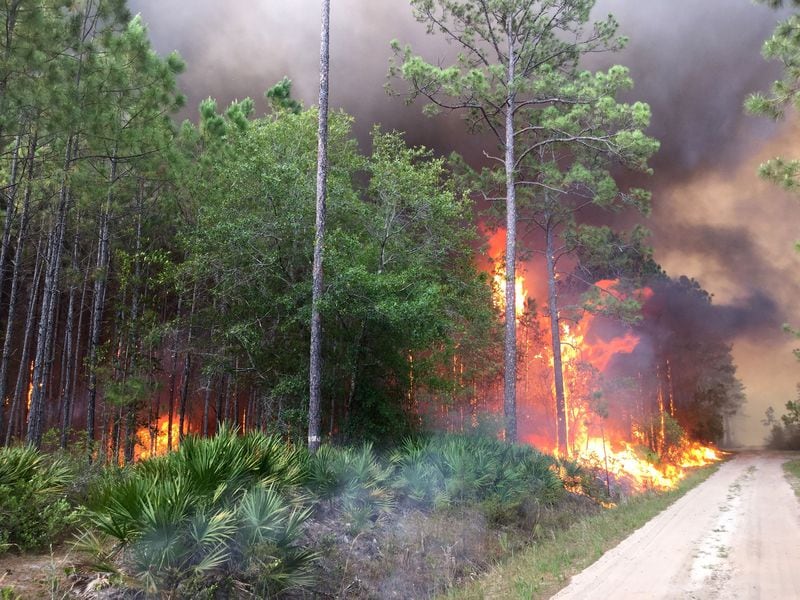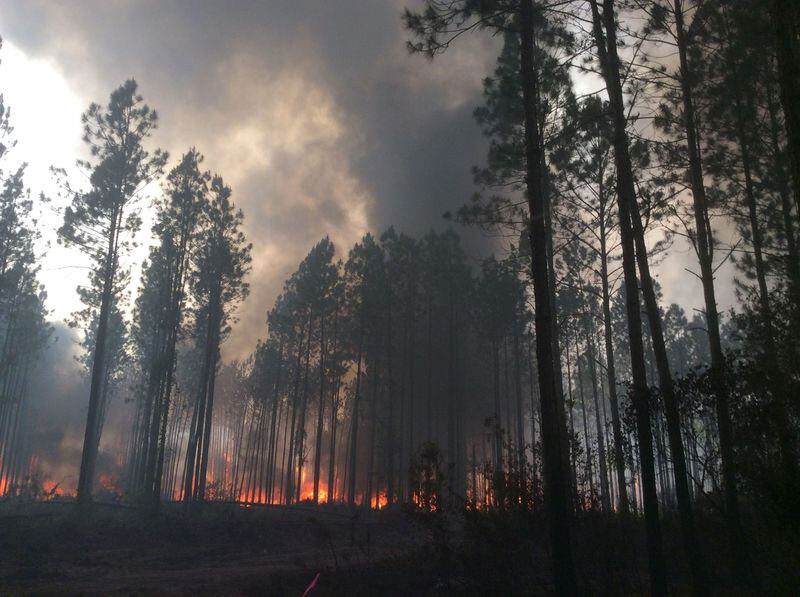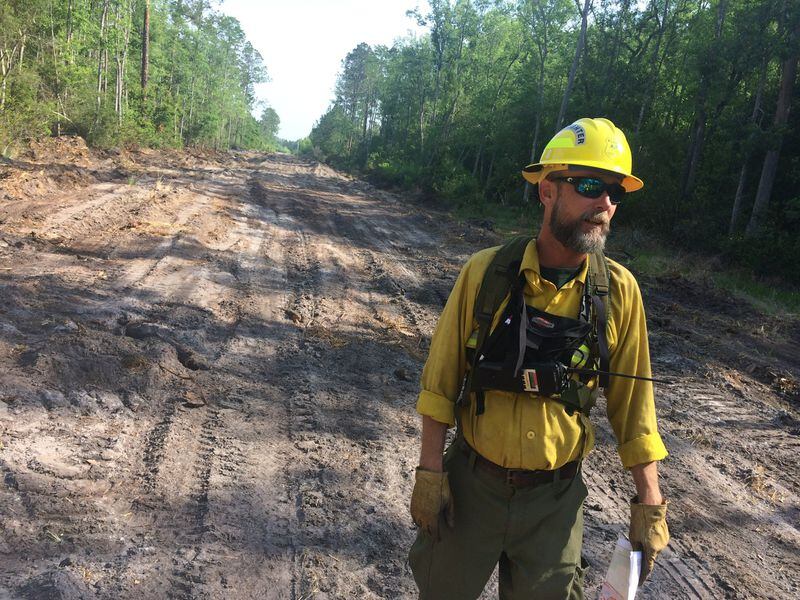Fighting the fire, crews sweat in the searing heat of flame and sun, running bulldozers over hot spots, firing water jets at burning trees and tamping down the simmering earth.
They call it holding the line, the barrier between the 225 square miles of fire-damaged swamp and woodlands and the South Georgia communities that sit nervously nearby. Places like Canady Loop, Moniac and St. George.
So far, a month after a lightning bolt started the fire in the Okefenokee Swamp, the 700 firefighters from some 36 states have been largely successful. They've not let a single life or home perish.
Credit: HANDOUT
Credit: HANDOUT
It is backbreaking and frustrating work, for they know they’ll be back doing the same thing tomorrow and the day after and so on. There’s really no end in sight to this fire, the largest active wildfire in the nation, with officials saying it could last until November. Right now, only 12 percent is considered contained. It engulfs an area nearly twice the size of the city of Atlanta, and it continues to grow.
“Obviously we don’t do it for the money,” said Trent Ingram, a division supervisor working on the front lines. “But when somebody says thank you for saving my home, it makes it worthwhile.”
Over the past week, the frustration has grown along with the fire. Officials have expanded the areas they want evacuated (though few people have complied). Now the school is closed in the small town of St. George, and several main roads are closed to travel.
Usually this time of year, the busiest activity in this place is people swatting away the gnats. But now, day after day, people keep checking to see if the wind is picking up, and eyeing the sky for new signs of smoke, trying to see if the blaze is coming closer.
“I can’t sleep, not peacefully,” said Lisa Bell, 48, who has chosen to stay in an area under evacuation. The law prevents authorities from forcing her to go. She has already lost a home to an electrical fire. “I just want to survive and not lose a home.”
In many ways, people here are trying to get on with their lives, cutting the grass, going to work, buying groceries. But they can’t avoid the many ways their town has changed. Now the sleepy center of town — little more than a few stores and a burger place — is filled with police roadblocks, scads of media trucks and crisscrossing fire and emergency vehicles.
Bell was in Canady’s Grocery buying supplies, but even this activity was altered. She purchased water and ribs, knowing that once they were cooked they could last several days. Just in case.
This region is no stranger to wildfires, but even veteran firefighters say this one is different, bigger and stranger in its behavior. It keeps spreading, sometimes jumping half a mile ahead or farther, starting a new blaze. From the start, the conditions — drought-dry weather, little humidity and lots of wind — have played in the fire's favor.
Credit: HANDOUT
Credit: HANDOUT
Ingram and his fire crews found themselves in a mess of trouble the other day. The fire, riding on a shifting wind, made a big run, slamming into Ga. 94. His team had set up shop in a small building across that road, and they had to leave in a hurry as the fire jumped across the road.
Flames in the trees shot up over 100 feet in the air, he said. He knew there was no stopping it, so they let the fire pass and then attacked it from the sides. They threw everything they had at it. Bulldozers, tractors, water engines and air tankers dropping flame retardant from above — all trying to steer it away from St. George, only a few miles away.
It took hours, virtually an entire day, to accomplish that. On Thursday, he showed the spot to The Atlanta Journal-Constitution. The once-tall yellow grass was blackened. Pine trees were dark and stripped of their needles. And the small building was gone.
» PHOTOS: South Georgia wildfire rages in Okefenokee Swamp
Every day has been a new battle. Wednesday was considered a good day in that the fire spread only about 200 acres. Last weekend, it was advancing thousands of acres a day. The firefighters speak of the fire as a living, breathing enemy. They use terms familiar to the military. The fire is advancing, crews are attacking on the front lines.
Back in St. George, Thursday seemed a pretty good day. You could see blue in the sky above, not just the sooty gray of smoke. There seemed to be less of the smell of smoke in the air. Much here depends on which way the wind blows.
The fire has damaged 144,073 acres, but it is not as though all of those acres are still burning. The majority have burnt out, said Joe Zwierzchowski, a spokesman for the agencies fighting the blaze.
As so often occurs when a crisis looms, people have come together. The gymnasium at the St. George Church of God has become a hive of volunteer activity. People have brought in all sorts of food and supplies for the firefighters. Pastor Grady Allbritton said word got around that the firefighters were finding it hard to find food. That's all it took. His wife Debbie started cooking lots of her Chicken Alfredo, and others followed suit.
Now, every day a cadre of women show up at the church to cook for and feed the firefighters. People like Patricia Smith, who said she wants the firefighters to know they are appreciated.
“God put it in my heart,” she said as she manned the sweet tea station in the gym. “They keep our homes safe.”
A few minutes later, a spokesman for the agencies fighting the fire, Larry Helmerick, stood up in front of the gym to offer the group an update on what to expect Friday.
“I’m not going to sugarcoat it. It’s going to be a trying day, ” he said. Along with the dry conditions and high temperatures, the wind was expected to pick up.
The crowd groaned collectively.
“We’re used to it, ” he said. Then he corrected himself. “We never get used to it.”
About the Author








